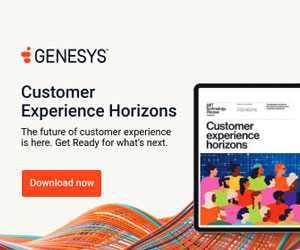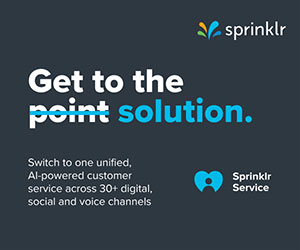Arpita Maity at Genesys explores how virtual agents, powered by AI and large language models, go beyond traditional chatbots to deliver more adaptive, personalised, and efficient customer interactions.
With customer care volumes increasing and agent attrition already nearing 40%, these trends are creating a snowball effect in contact centres that can negatively impact customer experience and reduce revenue.
To address this challenge, businesses turn to bots to fill the gaps. But while traditional chatbots have been the standard solution for boosting self-service capabilities, they were designed for more limited purposes. Bots are predefined with a specific task and offer limited flexibility.
They can’t handle ambiguity like a human can, converse on a particular topic or personalise information in a way that’s unique to your brand. Handing off complex queries to human agents is possible, yet without context it forces customers to repeat themselves – contributing to bad customer experiences.
Virtual agents, the next step in conversational AI, supercharge self-service by helping organisations extend their reach through context and adaptability.
Instead of responding only to specific inputs, virtual agents use AI and natural language understanding to interpret customer needs in real time, dynamically adjusting responses based on conversation flow and capturing context that can also be handed off to human agents.
This enables more personalised, complex interactions than function-based chatbots. And while they work seamlessly with human agents on handoffs, they’re also trained to express empathy for your customers.
Virtual Agents: The Next Frontier for Traditional Bots
In the past, initial conversations about implementing a bot would be about its function: Should it be a chatbot or a voicebot? And then, what queries will it handle?
The next step would be to figure out the flow for the bot to manage its tasks, and then design that flow.
After all that effort, you might end up with a decent bot, but one with significant limitations. If the bot encounters a question outside its predefined script, it’s stuck.
It can’t learn from new data, improve its responses over time or understand the context of a request to provide more relevant answers.
The advancements in AI technology, especially large language models (LLMs) and generative AI, have made it easier for businesses to realise the potential of virtual agents. They can adapt their responses as they learn from user behaviour and enhance personalisation and efficiency.
Let’s look at six ways that virtual agents take traditional bots to the next level – and the striking benefits your business can expect.
1. Building Intents That Go Beyond Static Scripts
Virtual agents greatly expand the scope of what a traditional bot can do. The first place we see this evolution is in building intents. This used to require meticulous management of each individual utterance, with constant tuning over time. But LLMs have changed that.
It’s much simpler to define and design the steps to resolve a task, with a series of LLM-based actions in a flow that focuses on very narrow activities.
This flow-based design ensures that your solution will only do as it was trained, and that training is easier or even automated.
Basically, you give a description of a task, such as “collect information” or “find an article,” and then the LLM works on it.
This makes the setting of intents, the path and the flows more versatile in natural-sounding language than in the past.
This versatility enables virtual agents to handle more complex interactions and even do “intent switching” – taking on a more human-like approach to handling interactions.
Let’s say that a customer asks a virtual agent a question about a product function. Once the virtual agent answers that question, the customer could have a completely new question.
At that point, the virtual agent can seamlessly switch to inquiry mode – and even refer back to the original question.
The customer interacts with the virtual agent in the same way that conversations shift with humans, without specific instructions. It can also personalise its response based on the exact question – and cite the source to verify the information.
2. Comprehensive Handovers to Agents and CRM Systems
Chatbots can’t capture the context of customer interactions or perform handovers to the extent that virtual agents can. The bot handover lacks the interaction summary, background and wrap-up codes of the interaction they just completed with a customer.
After an interaction, the virtual agent chooses the appropriate next step. If a human agent needs to take over a query, the virtual agent can create a summary and pass that along as part of its escalation.
This enables the agent to pick up the conversation where the virtual agent left off. The result is that customers do not need to repeat themselves, which offers a direct improvement in the customer experience.
But if the task was fully completed, the virtual agent will write a summary and tag one of your predefined wrap-up codes to the conversation, performing the same post-interaction practices that you’d expect from a human agent.
In this way, it handles several time-consuming tasks and captures insights in a consistent manner. In both cases, the virtual agent saves its details in your CRM systems so other tools, virtual agents, administrators and human agents can use them.
3. Visibility Into Customer Journeys to Proactively Address Issues
Traditional chatbots typically can’t access and use analytics that would reveal gaps in the customer journey throughout a lifecycle.
They don’t know what information might be missing, or that they should try to find it. Virtual agents, however, can identify what’s missing in every interaction and across multiple touchpoints.
The insights provided are actionable, which differs from a traditional dashboard of metrics that require time to make sense of.
Using AI-powered intent and sentiment analysis helps make the continuous improvement of the customer experience or contact centre a reality.
Data can reveal common pathways taken, where customers drop off and other inefficiencies to improve for better journeys.
Through integration with CRM systems, these details enable you to optimise customer experiences by proactively determining which gaps to address that will improve service delivery.
4. Virtual Agents Eliminate the Heavy Lifting
Even with their limited capabilities, it takes a lot of work for chatbots to perform well. And that work requires technical skills, including teams of data scientists. It’s a heavy lift for specialised resources that are hard to find. And bot training requirements make it even more complex.
In contrast, virtual agents can be designed and deployed by non-specialised resources.
5. Virtual Agent Flows Are Designed for Reusability
Virtual agents eliminate the need to build bot flows from scratch because the flows generated for virtual agents are reusable across all AI solutions.
There’s no need to recreate flows for different purposes or types of digital support. This increases ROI by simplifying maintenance and using fewer resources to efficiently scale and optimise interactions.
Reusability is possible because virtual agents keep humans in the loop. They seamlessly escalate complex issues to human agents, providing context from current and previous interactions.
They also enable real-time human oversight, ensuring that AI-generated responses are accurate and compliant. Because there’s always a human in the loop, it ensures that data is clean and secure for reuse.
Over time, you’ll continue gaining ROI because your data doesn’t require a constant check on whether processes are good, data is accurate or you’re performing well.
6. Security Guardrails Are in Place
Some companies launch AI initiatives in-house, such as building their own custom GPTs, assuming their own expertise will translate into cost savings.
While building custom GPTs for business use offers flexibility, it can introduce significant risks. Data security and privacy issues are major concerns, in part because of many instances of AI going rogue without proper guardrails.
Generative AI is expected to substantially increase labour productivity across the economy. By automating tasks, improving the quality and complexity of responses, and eliminating the need for continual updates, virtual agents can contribute to an uptick in productivity and ROI for your contact centre. But even they have limitations.
For example, custom models may generate inaccurate or biased responses, impacting customer trust. And there are ethical risks with unintended or inappropriate outputs or hallucinations.
Virtual Agents Transform Bots Into Differentiators
This transformative leap from traditional chatbots to virtual agents is powerful and flexible, yet it’s easy to achieve value quickly.
Their ability to seamlessly integrate with existing bot flows, handle complex interactions and provide deep visibility into customer journeys makes them a powerful tool for enhancing customer experiences.
This blog post has been re-published by kind permission of Genesys – View the Original Article
For more information about Genesys - visit the Genesys Website
Call Centre Helper is not responsible for the content of these guest blog posts. The opinions expressed in this article are those of the author, and do not necessarily reflect those of Call Centre Helper.
Author: Genesys
Reviewed by: Megan Jones
Published On: 4th Mar 2025
Read more about - Guest Blogs, Genesys






 Genesys empowers more than 8,000 organisations in over 100 countries to improve loyalty and business outcomes by creating the best experiences for their customers and employees. Through Genesys Cloud, the AI-Powered Experience Orchestration platform, Genesys delivers the future of CX to organisations of all sizes so they can provide empathetic, personalised experience at scale. As the trusted platform that is born in the cloud, Genesys Cloud helps organisations accelerate growth by enabling them to differentiate with the right customer experience at the right time, while driving stronger workforce engagement, efficiency and operational improvements.
Genesys empowers more than 8,000 organisations in over 100 countries to improve loyalty and business outcomes by creating the best experiences for their customers and employees. Through Genesys Cloud, the AI-Powered Experience Orchestration platform, Genesys delivers the future of CX to organisations of all sizes so they can provide empathetic, personalised experience at scale. As the trusted platform that is born in the cloud, Genesys Cloud helps organisations accelerate growth by enabling them to differentiate with the right customer experience at the right time, while driving stronger workforce engagement, efficiency and operational improvements. 





























